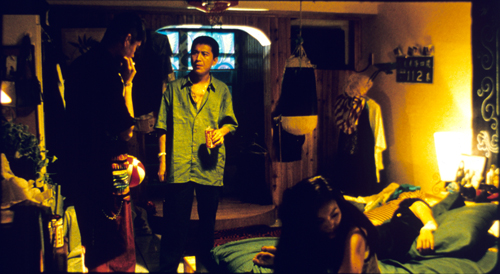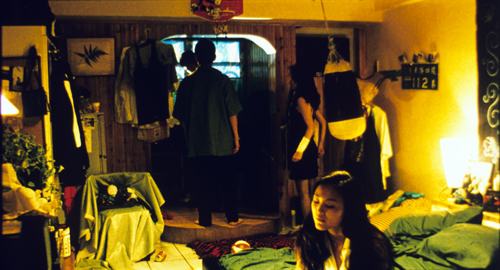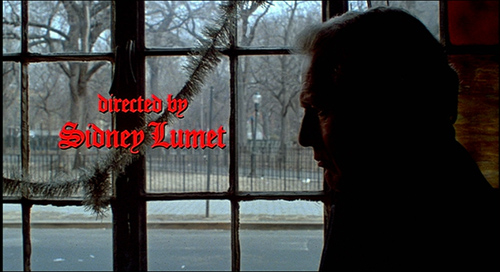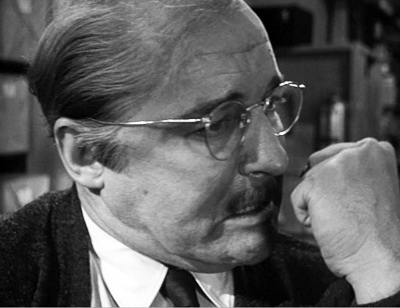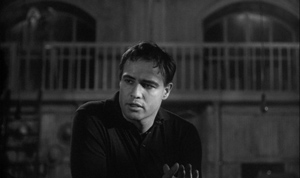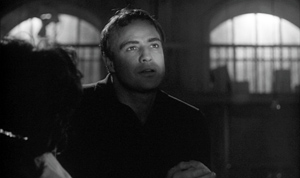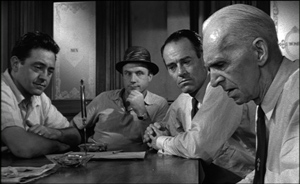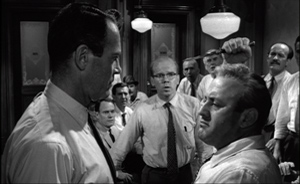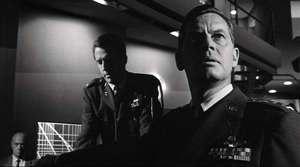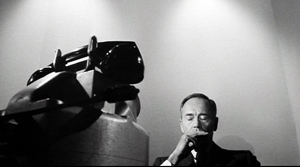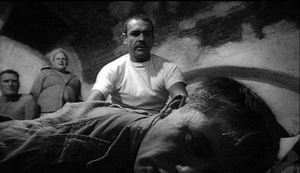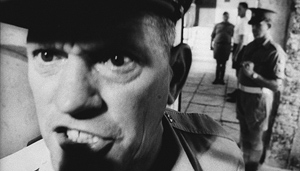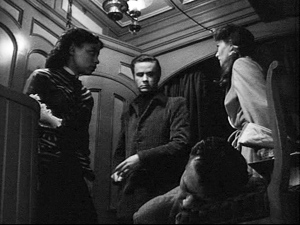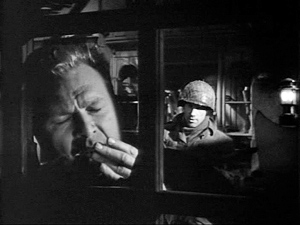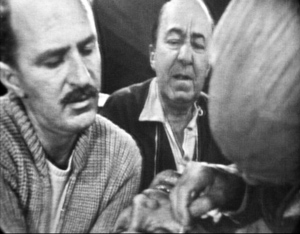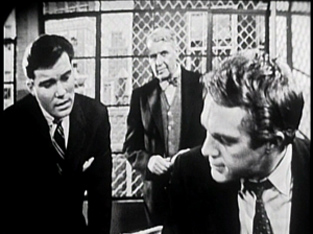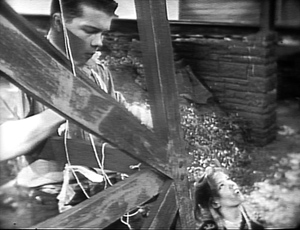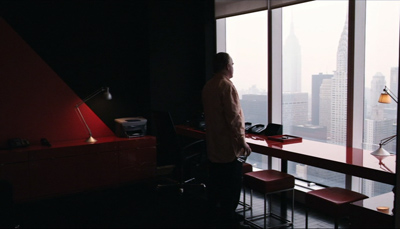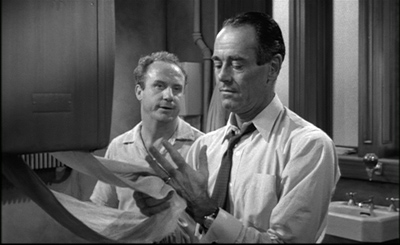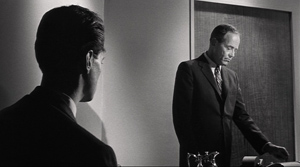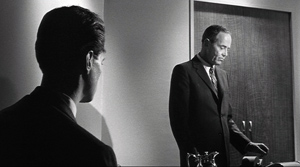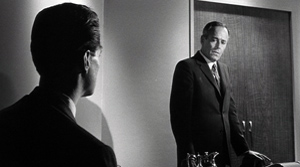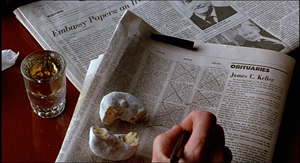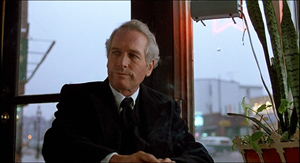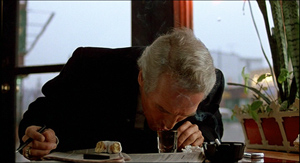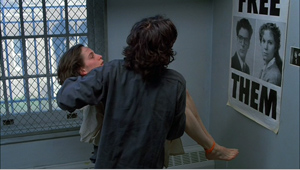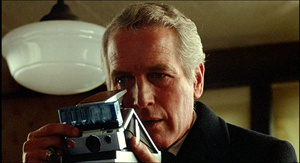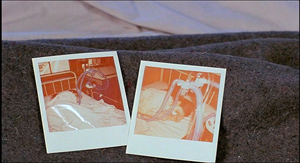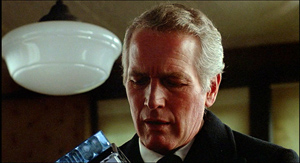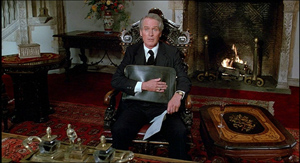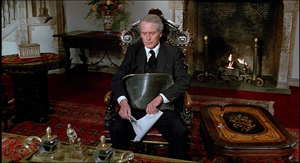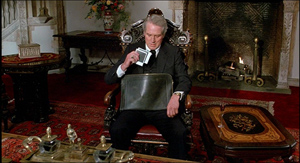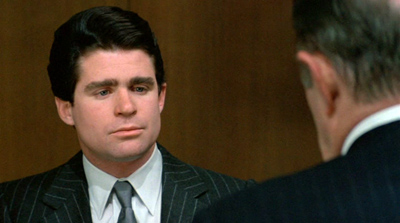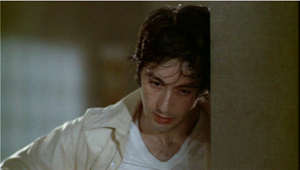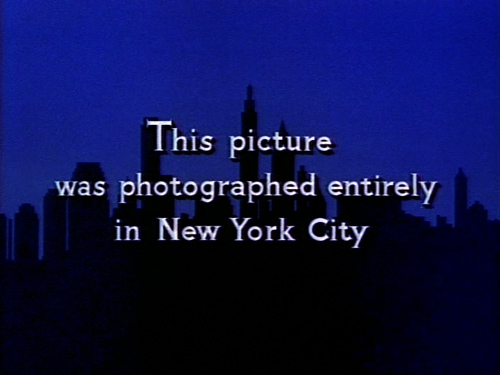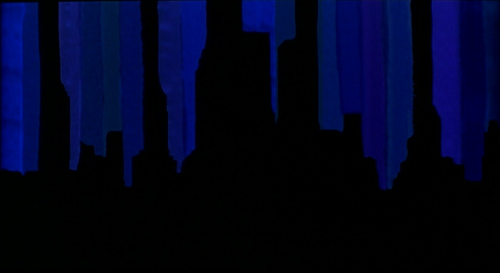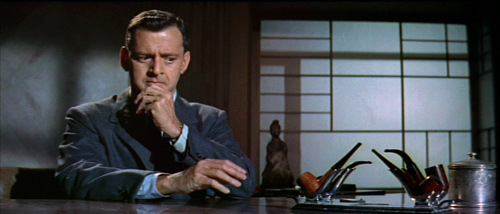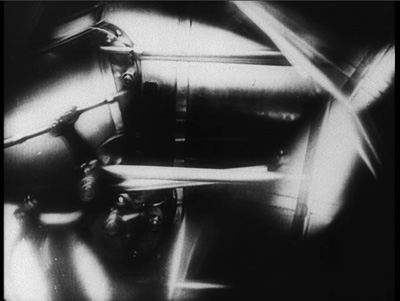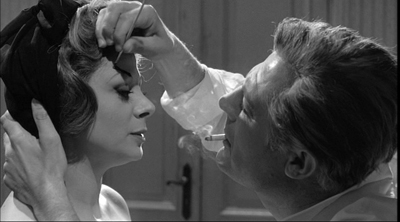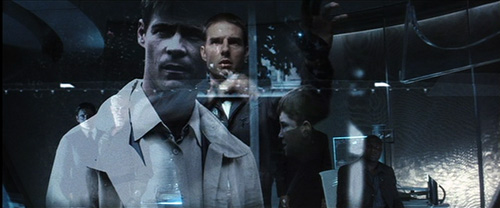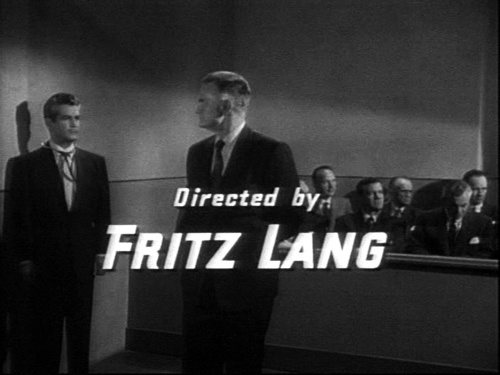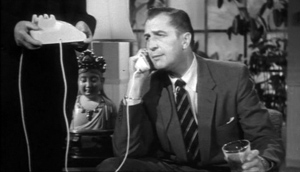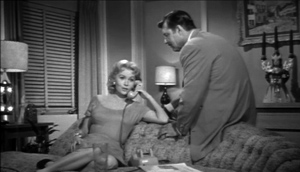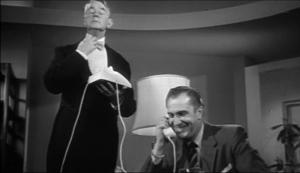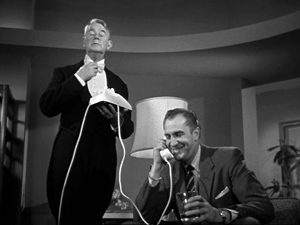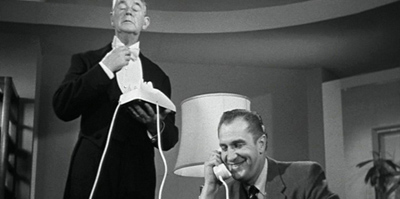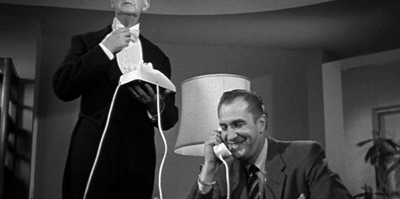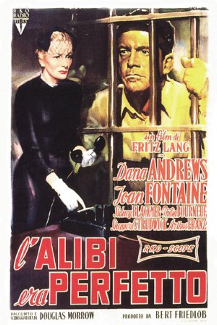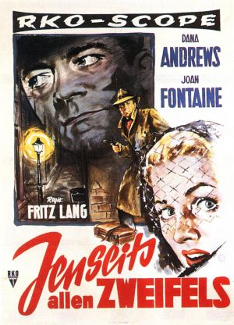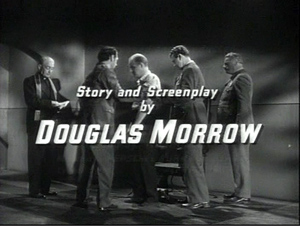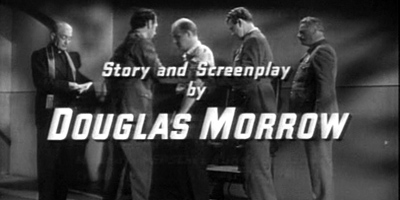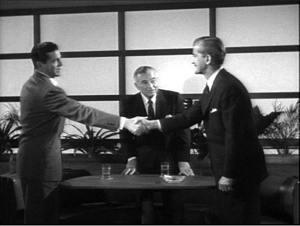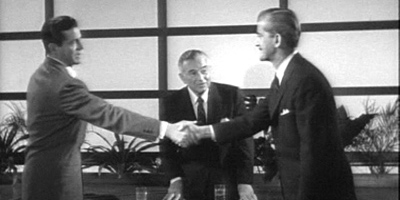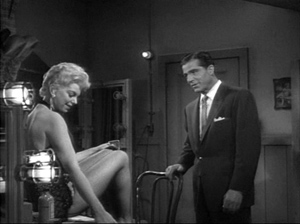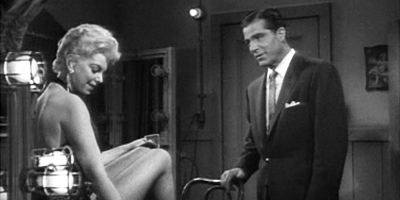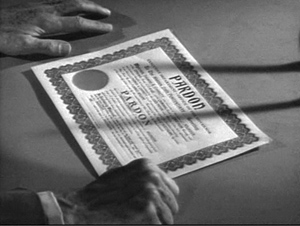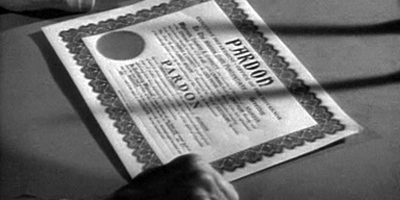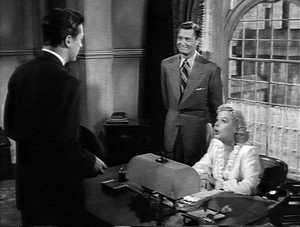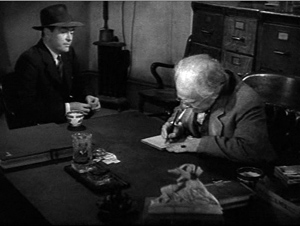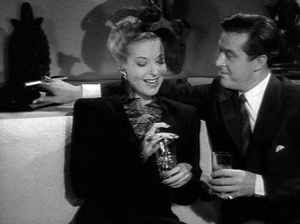Archive for the 'Film criticism' Category
Another quick one
Goodbye South, Goodbye: Kao confronts Flathead while the women tune out.
DB here:
The newest issue of Film Comment includes an essay I wrote on the relations between academic film studies and cinephile criticism. It’s online at the Film Comment site.
Two things: The header (“Never the twain shall meet”) risks misleading you. The essay argues that the twain can and should meet. Secondly, the essay refers to stages of a long take in Hou Hsiao-hsien’s Goodbye South, Goodbye, but neither the Web version nor the print version uses the images I suggested as illustrations. So here, in frames from a 35mm print, I present two phases of this gloriously dense scene. I discuss Hou’s staging principles in Chapter 5 of Figures Traced in Light, with comments on this passage on pp. 234-236.
As a followup, and weirder: The Way Hollywood Tells It is now available as an audio book. How it handles the pictures I don’t know. But you can listen to a sample here.
If the scene has a climax, this is probably it. As the punching bag swings, Flathead wriggles out the window.
Endurance: Survival lessons from Lumet
I don’t believe in waiting for the masterpiece. Masterful subject matter comes up only rarely. The point is, there’s something to advance your technique in every movie you do.
DB here:
Across half a century he outpaced his contemporaries. He was the last survivor of the vaunted 1950s generation of East-Coast TV-trained directors, men who went over to theatrical films just as the studio system was in decline. John Frankenheimer, Martin Ritt, Richard Lester, and Franklin J. Schaffner won big projects early on, but they also faded faster. As they were moving out of the game in the 1970s and 1980s, Lumet was getting his second wind. He ground movies out–good, so-so, or wretched–like a contract director of the studio days. Sometimes he had a strong stretch, as in the early 1980s, and sometimes not. He started in his early thirties with Jean Vigo’s cameraman Boris Kaufman, shooting crystalline black and white. At the end he was making a feature in high-definition video.
When Lumet died on 9 April, journalists were generous in their praise. But most of the eulogies seemed to me constraining. They overlooked his complicated role in postwar American film, and they neglected to supply the sort of historical context that make even his negligible films of interest. Concentrating on his official masterpieces (Dog Day Afternoon, Network), the obituaries cast him as a hard-nosed urban realist. That’s part of the story, but if we want a fuller picture of this long-distance runner, we need to trace his path in more detail. That in turn can teach us something about shifting generational opportunities in American cinema.
We can start by noting what the recent accolades seem to have forgotten: at the start of his career Lumet faced brutal hostility from the critical intelligentsia that ruled his home town.
Danger man
The Pawnbroker.
Reading 1960s film criticism, you might think that Sidney Lumet was the biggest threat to film art since the Hays Code. Young cinephiles today may be unaware of the vituperation that New York’s highbrow critics showered on him at the start of his career.
John Simon: “What is Lumet good at? Intentions, underlining, and casting.”
Manny Farber: “Giganticism is, of course, the main Lumet contribution [to The Group]. . . . Miss [Shirley] Knight, in a concentrated post-coitus scene atop [Hal] Holbrook’s chest, has a head the size of a watermelon.”
Andrew Sarris: “The Pawnbroker is a pretentious parable that manages to shrivel into drivel.”
Most tireless was Pauline Kael, who throughout the decades picked off nearly every Lumet movie with the casual contempt of Annie Oakley shooting skeet. From the backhanded compliment (“The Pawnbroker is a terrible movie and yet I’m glad I saw it”) to the eviscerating dismissal (Deathtrap is “an ugly play and what appears to be a vile vision of life”), Kael did not relent. She found Lumet’s staging “slovenly,” his color schemes inept; in Serpico “scene after ragged scene cried out for retakes.”
The hunt was in full cry in Kael’s 1968 essay, “The Making of The Group,” one of those behind-the-scenes journalistic forays that always end in tears for the production. Every such think-piece mysteriously assures the film’s commercial failure, while guaranteeing that posterity will remember each participant as a knave or a fool. Yet for sheer bloodthirstiness, Kael’s reportage easily surpasses that of her predecessor Lillian Ross in Picture.
Kael is out to show that the conditions of acquiring, producing, and marketing films have become almost utterly corrupt. No artist can survive the system. So she starts by establishing Lumet as merely a journeyman, shooting the script as a straightforward job of work.
But then things get rough. He is, for one thing, a poor craftsman.
He cannot use crowds or details to convey the illusion of life. His backgrounds are always just an empty space; he doesn’t even know how to make the principals stand out of a crowd . . . . Lumet is prodigal with bad ideas . . . . He will take the easiest way to get a powerful effect; in some conventional, terribly obvious way he will be “daring” . . . The emphasis on immediate results may explain the almost total absence of nuance, subtlety, and even rhythmic and structural development in his work. . . . I was torn between detesting his fundamental tastelessness and opportunism and recognizing that at some level it all works. . . . Because Lumet can believe in coarse effects he can bring them off.
He is also a severely deficient human specimen.
[He was] the driving little guy who talked himself into jobs . . . He seems to have no intellectual curiosity of a more generalized or objective nature . . . For Lumet, a woman shouldn’t have any problems a real man can’t take care of . . . . He’ll go on faking it, I think, using the abilities he has to cover up what he doesn’t know.
Kael has her generous moments, praising Long Day’s Journey into Night (1962), chiefly because of the performers, and in later years she would admire scenes in Dog Day Afternoon (1975). But usually her admiration boomerangs into a complaint (Lumet yields a fast pace, but that makes him slapdash). On the whole she and her Manhattan peers, who seldom agreed on anything, conceived Lumet as dangerous.
Why? Partly because they mostly set themselves against the middlebrow culture of the newspapers and newsweeklies. Many of Lumet’s early films were admired by staid critics. Praise from these quarters was anathema to the sophisticates. Somebody had to tell the Times’ Bosley Crowther that The Pawnbroker (1965) was not “a powerful and stinging exposition of the need for man to continue his commitment to society.”
Another strike against Lumet was his pedigree. He was said to have brought TV technique, simultaneously bland and aggressive, to theatrical cinema. Early live TV drama, confined by the home screen’s 21-inch format and weak resolution and hamstrung by punishing shooting schedules, pushed directors to rely on flatly staged mid-range shots, goosed up with close-ups, fast cutting, and meaningless camera movements.
Kael suggests that Frankenheimer, a common foil to Lumet at the period, managed in films like The Manchurian Candidate (1962) to convert the TV look into “a new kind of movie style,” though she never explains what that consists of. By contrast, Lumet simply followed the line of least resistance, emptying out his shots and “hammering some simple points home.”
There’s nothing on the screen for your eye to linger on, no distance, no action in the background, no sense of life or landscape mingling with the foreground action. It’s all there in the foreground, put there for you to grasp at once.
The TV style threatened to suffocate the glories of cinema: the full view, a more leisurely unfolding of action, a sense of life flickering on the edges of the plot. For Kael the TV-trained Lumet exemplifies the loss of the great tradition of artistic moviemaking personified in Jean Renoir.
Lumet was dangerous in another way. He seemed part of a trend toward heavy-handed showoffishness. Partly the trend was seen in the sweaty strain of Method acting, typified in Kazan’s work. Manny Farber proposed that the Method was at the center of the “New York film,” a fake realist package predicated on psychodrama, arty compositions, and liberal pieties. 12 Angry Men was “counterfeit moviemaking,” filled with “schmaltzy anger and soft-center ‘liberalism.’” Hard-sell cinema, Farber called it. Dwight Macdonald saw the same bludgeoning in The Fugitive Kind.
Lumet’s direction is meaninglessly over-intense; lights and shadow play over the close-up faces underlining lines that are themselves in bold capitals; every situation is given end-of-the-world treatment.
The new tendency toward self-conscious artifice didn’t just have New York roots. The French New Wave’s somewhat disjunctive cutting, unexpected camera movements, freeze-frames, and other flagrant techniques made audiences and filmmakers aware of film style to a new degree. Tony Richardson, John Schlesinger, and other directors scavenged these devices to give their films an up-to-date panache. Once more a critic needed to invent a new label for Lumet: Macdonald claimed that he was an exponent of the Bad Good Movie, “the movie that is directed up to the hilt, avant-garde wise,” in the vein of Mickey One, The Servant, The Trial, and the work of Godard. The Pawnbroker’s fragmentary flashbacks led Sarris to call it Harlem mon amour.
Harsh as they are, these comments do have a point. The early films shout and scream a lot, both dramatically and pictorially. Lumet admitted his love of melodrama, conceiving it not simply as overplaying but rather as conflict at the highest pitch of arousal: extreme personalities in extreme situations. So a silence is usually prelude to an outburst, and a bellow or a slap is never far off. The jury deliberations in 12 Angry Men (1957) become a group therapy session (or an Actors Studio class?) in which bigots must confess their traumas.
Stage Struck (1958) and The Group (1966) are pictorially innocuous, perhaps partly because they were shot in color, but The Fugitive Kind (1960) is a banquet of elaborate lighting effects whipped up by Kaufman. Macdonald wasn’t fair in his dismissal; the film is dominated by medium and long shots, with close-ups held in reserve for big moments, and the line readings don’t seem to me as overbearing as he suggests. Still, there is a sense of pressure, with very precise reframings and sets densely packed (mirrors, curtains, staircase railings) in a way that accords well with Williams’ overripe dialogue. There is an upside-down shot, and at some moments, as Macdonald notes, the illumination lifts or drops in magical ways—a surprise gift, Lumet claims, from Kaufman.
As a pluralist, Lumet would stage some scenes in full shots and long takes, sometimes at a surprising distance from the camera. But it was hard not to notice the other extreme. His most famous black-and-white films mixed in tight close-ups, oppressive sets, wide-angle distortions, and chiaroscuro. 12 Angry Men is relatively subdued in this regard, building toward more looming images at the climax, with some powerfully jammed ensemble frames.
Fail-Safe (1964) surrenders itself to flamboyant shot design once we get into the war room and then into the President’s sealed chamber. Contra Kael, as in 12 Angry Men, many of these shots have busy backgrounds, albeit not of the Renoirian sort.
The Pawnbroker (1965) is Lumet’s most famous orgy of strident technique, with Sol Nazerman nearly as caged at his counter window as he was in the camps. Even more overwrought is The Hill (1965) in which short lenses pump officers’ raging faces into gargoyle shapes, with pores and welts and gobs of sweat thrust under our noses.
In sum, this is not the director eulogized in Entertainment Weekly: “He never tried to dazzle audiences with flash and style.”
What critics didn’t note, however, was that the more outré look cultivated by Lumet, Frankenheimer, Ritt, and company fitted fairly snugly into 1950s Hollywood black-and-white dramatic style. The blaring deep-focus and violent close-ups exploited by the TV-born directors were already visible in the work of Mann (The Tall Target, 1951, below), Aldrich (Attack! 1956, below), Fuller, and many other directors.
During the 1950s what we might call roughly the “post-Welles” look was well-established for serious subjects and genre pictures alike. The Hill pushes things a bit, as Frankenheimer did in Seconds (1966), but the cramped, low-angle style on display in Lumet’s early work is part of a tradition that goes back years (and which had its echoes in many overseas directors, such as Bergman and Fellini). The wilder reaches of that style, it now seems clear, belonged to Fuller and company, not to mention the Kubrick of Strangelove and the Welles of Touch of Evil. Like Richardson, Schlesinger, and others, the TV émigrés may have gotten their wrists slapped for trying to map onto prestigious social-message movies the visual pyrotechnics already acceptable for program pictures.
Not incidentally, some directors had already found the wide-angle deep-focus look useful in their TV productions. Below are frames from Requiem for a Heavyweight (directed by Ralph Nelson, Playhouse 90, 1956); The Defender (directed by Robert Mulligan, Westinghouse Studio One, 1957); and Lumet’s own omnibus program Three Plays by Tennessee Williams (Kraft Television Theatre, 1958).
You can argue that their move to cinema actually smoothed out the directors’ style. The less square frame and bigger scale of the theatre screen made films like Frankenheimer’s debut The Young Stranger (1957) more spacious and relaxed than what could be seen on the box. 12 Angry Men was a polished effort, starting with an elaborately staged six-minute crane shot assembling the cast in the jury room, and using the width of the screen to enclose several faces. Looking back, we can see that Lumet offered something quite close to then-current Hollywood norms, and it looked less crude than what would be found on live TV of the period.
Still, The Pawnbroker and other films can be credited (or blamed) with helping spread the in-your-face style that would come to dominate American cinema of the next fifty years: disjunctive editing, slow motion, the arcing tracking shot (The Group), handheld shooting for moments of violence or anguish, glum color schemes (preflashing for The Deadly Affair), the teasing flashbacks that will be gradually filled in. Lumet’s early films are anthologies of most of today’s tics and tricks.
Yet by the time of his death, the director who was once feared as the vanguard of something new and awful had come to embody something old and trustworthy. Somehow the unambitious journeyman and pretentious copycat became a “classicist.”
How did that happen?
A prince of the city
Before the Devil Know You’re Dead.
Instead of indicating that he was joining or extending a tradition, Lumet reacted to the hailstorm of criticisms with surprising equanimity, at least in the interviews he gave so abundantly throughout his career. He was modest, acknowledging that many of his films turned out to be feeble, and he declared himself a learner. He tried different projects, he said, to improve himself. He wanted to learn to manage color, to work in different genres (e.g., the dark comedy Bye Bye Braverman, 1968), eventually to fall in love with digital video capture. To some extent Lumet changed because he really wanted to learn more and explore various sides of moviemaking.
Lumet always claimed that he didn’t apply a personal style to his projects; he tried to find the best way to handle the script. He thereby confessed himself to be what auteur critics of the 1960s were calling a “metteur-en-scène,” the director who judiciously enhances the material rather than transforming it to suit his personality. This was probably a good survival strategy in the new churn of the 1970s.
The mid-1970s was the Great Barrier Reef of American cinema. Virtually no members of Hollywood’s accumulated older generations, from Hitchcock and Hawks through the 1940s debutantes (Wilder, Dmytryk, Fuller, Siegel) and the 1950s tough guys (Aldrich, Brooks) to the TV émigrés, made it through to 1980. Many careers just petered out. The future belonged to the youngsters, the so-called Movie Brats. In this unfriendly milieu, Lumet fared better than most. He tried a semifarcical heist film (The Anderson Tapes, 1971) that mocked the rise of the surveillance society, with everybody wiretapping and taping and videoing everybody else. He mounted a classic mystery (Murder on the Orient Express, 1974), a musical (The Wiz, 1978), and a free-love romance (Lovin’ Molly, 1974). Of the items I’ve seen from these years, the most daring is The Offence (1972). This study of a sadistic British police inspector’s vendetta against a child molester offers a sort of seedy expressionism. In another gesture toward psychodrama, long conversations with the perpetrator reveal that the copper is a bit of a perv himself.
Lumet’s most successful rebranding took place in a sidelong return to the Pawnbroker milieu: low-end, location-shot, crime-tinged social commentary using New York theatre talent. Filming in color and casting off the baroque precision of the earlier work, he made his compositions more casual and his shot changes less precise. His cutting pace picked up: six seconds on average for Serpico (1973), five for Dog Day Afternoon (1975), both courtesy of the high priestess of the quick cut, Dede Allen. The driving tempo of these movies gave them an urgency that critics could tie to the ticking-clock plots, the atmosphere of urban pressure, and of course the extroverted acting of Al Pacino.
With the two crime films, and the satiric Chayefsky talkfest Network, Lumet remade his image. He was a New York filmmaker, offering raucous, hard-nosed, semi-cynical takes on corruption in the police, the justice system, politics, and the media. His protagonists tended to be Jews, Italians, and Irish, all working stiffs or bare-knuckle power brokers; and the enemy, again and again, turned out to be the Ivy elite. A tailor-suited WASP, male or female, was likely to sell you out. Only ethnic minorities knew the real score. The line could come from almost any mid-career Lumet film: “I know the law. The law doesn’t know the streets.”
The crowning achievement in this vein, for critics if not for audiences, was Prince of the City, a sprawling study of a cop’s patient years of taping and informing on his corrupt colleagues. More slowly paced than the earlier urban dramas, the film also marked Lumet’s move toward something else again. The style was drier and more sober, almost passive, emphasizing static and somewhat distant setups; the cutting slowed down to nearly nine seconds on average. As mid-period Lumet had blotted out the early years, now something more calm, even comparatively austere, came into view.
Whatever the project, however, by the later 1980s he was offering his own alternative to the fast-cut, whirlicam style that was bewitching young filmmakers. While directors in all genres were building scenes out of endless choker close-ups and cutting every four or five seconds, Lumet applied the brakes, lingering on two-shots, letting whole scenes play out in full frame, moving his actors around and ordaining a cutting pace close to ten seconds on average. The first eight minutes of The Verdict (1982) consist almost entirely of long shots and extreme long shots. The protracted takes and antic bodily contortions of Deathtrap might have come from a French boulevard farce; the first tight single of Christopher Reeves is delayed for half an hour. In an age in which critics decried the choppy confusion of tentpole action, the plainness on display in movies like Running on Empty (1988) and Night Falls on Manhattan (1997) looked anachronistic. Right to the end, Before the Devil Knows You’re Dead (2007) could spare a lengthy and distant shot to register a high-end drug boutique and shooting gallery. We had come from the Hysterical Lumet by way of the Gritty Lumet to the Restrained Lumet.
Acting in the frame
Yet he did not milk the urban crime vein dry. He continued to try a wide range of projects, even probing the Red Scare in Daniel (1983). The rationale was chiefly performance. Lumet was an “actor’s director.” He demanded at least two weeks of rehearsals, which included not only table readings but eventually full blocking of scenes, including fights and chases. Derived from his TV and theatre days, the method suited his belief that actors needed a firm structure in order to invent their characters. Interestingly, this actors-first rationale can be adjusted to any phase of the rough stylistic development I’ve plotted. The high-pressure facial shots of the early films can highlight the minutiae of the performances. But so can mid-shots that let actors build in bits of business.
Manny Farber praised the moment when Fonda in 12 Angry Men dries his fingers at length, one by one. It shows, Farber says, “the jury’s one sensitive, thoughtful figure to be unusually prissy” and provides a “mild debunking of the hero.” But it’s not the unintegrated detail Farber claims; Fonda’s coldness is set up early in the film, when he stands remotely from his peers and shows no interest in them as men. And Fonda was always a master of finger-work, which Lumet could exploit in fastidious framings. In Fail-Safe as the President tries to halt the bombers rushing toward the USSR, Fonda projects the man’s minutely controlled apprehensions by pausing to rub his fingertips together, off in the corner of the shot.
This micro-gesture suddenly leaps, as Eisenstein might say, into a new quality: a worried facial expression.
More explicit is the characterizing moment in The Verdict when Frank Galvin (Paul Newman) starts his day with a sugar donut and a full glass of whiskey. The setup is concise: He has crossed off the wakes he’s visited, and his palsied hand can’t pick up the glass without spilling some.
So Frank checks to see if anyone is looking before, like a dog, he bends his head to slurp off a little.
It’s a simple but powerful image of degradation, far removed from the trembling mouth and bulging brows of Steiger in The Pawnbroker.
Lumet cared as much for camera technique as for acting maneuvers. His book Making Movies provides a virtual manual of movie style as draftboard engineering. His gearhead side was probably another legacy of the buccaneering days of live TV and the New-Wave inspired awareness of artifice. He took inordinate pride in his “lens plots” and lighting arcs, charting purely technical changes that would weave their way through the film. (In this he was ahead of his time; now most filmmakers develop these technique arcs, or at least they say they do.) Despite this almost mechanical conception of technique, though, late Lumet rediscovered a bare-bones simplicity of performance and framing that was willing to risk looking flat. In Daniel, he lets the angry young man whose sister has wasted away into madness confront the poster agitating for their dead parents. No tracking in, no circumnambulating camera, no heightened cuts or nudging score. And no need to see Daniel’s face. Susan merely lifts her head.
It’s as if the visual rodomontade of the Movie Brats drove Lumet toward a new sobriety. When Galvin is preparing to try the case of the girl left in a coma through medical malpractice, he visits the hospital and takes Polaroids of her inert body. The slowly developing images not only give us the fullest view of the girl we’ve had so far. They also come to suggest his dawning realization that this is more than just a chance for big money.
Galvin starts to grasp that letting the hospital settle out of court will allow the officials to write off their mistake. There is a human cost to simply getting the check. If he does it, he will now be a better-paid ambulance chaser. Yet he doesn’t stand valiant for truth; the drunk is scared, drained of dignity, and he clutches his portfolio as a sad, ineffectual shield.
Offered the money, Frank takes out the photos and weighs them against the check. Then with a sigh of exhaustion, contemplating the fool’s crusade he’s launching, he returns the check and drops the pictures into his bag.
Very simple visual storytelling; it might have come from a 1930s movie. But this stark presentation of moral decision, given as a straightforward framing of a man’s body, achieves a measure of artistic nobility in a year that gave us Porky’s and Rocky III.
Telling it all, holding some back
Prince of the City.
It’s good to remember such moments of pictorial storytelling because Lumet’s films, especially the early ones, tend to be gabfests. If Eugene O’Neill, Tennessee Williams, and Paddy Chayefsky, along with the Method acting tradition, are your coordinates, you will be drawn to chatterboxes and blowhards. Lumet loved the spoken word, which was after all the mainstay of live TV (“illustrated radio,” it was sometimes called). It’s not clear that he ever shook the habit. His characters usually step onstage leaking exposition, announcing their pasts, their personalities, their plans, and their deepest feelings. This has the advantage of making plot premises clear, but it reduces the figures’ mystery and their ability to surprise us, or to complicate our feelings about them.
Sometimes Lumet did let story construction do heavier lifting. It happens in The Pawnbroker, because the nearly catatonic Nazerman speaks so little that the fusillade of flashbacks provides his backstory. More daringly, the large-scale back-and-fill of The Offence, peppered with small memories but also looping around the central incident in the interrogation room, seeks to reveal Sergeant Johnson’s affinities with the suspected child murderer. We need to remember Lumet’s early fondness for time-shifting plots before we declare Before the Devil Knows You’re Dead an old guy’s effort to catch up with Pulp Fiction.
Even without benefit of broken timelines, Lumet could occasionally hold back information to reshape our first impressions. Take the central revelation of Dog Day Afternoon, when cuddly Al Pacino reveals that his “wife” is not the woman he’s married to (a nice plot feint here) but the man whom he loves. This apparently sensationalistic twist comes early enough to modulate into pathos when Pacino’s character dictates his two wills.
Prince of the City realigns our sympathies in a more intricate way. At the start, Danny is presented as a tormented soul. We’re led to think that he turns snitch because of things we see: the invitation to go undercover, his brother’s and father’s angry concern that his pals are crooked, and above all the shameful efforts he makes to get drugs for his informant. Once he turns, however, he can’t limit the investigation, and at nearly the end his treachery has broken the most important ties in his life.
But “nearly the end” is the operative term, because Prince of the City boldly appends a ten-minute epilogue showing Danny being investigated himself. The Danny we saw at the film’s beginning may have been steeped in corruption; the drug bust we saw included, behind the scenes, a major ripoff of money; he has lied more than we realized; and it seems likely that he cheated on his wife with the prostitutes whom he supplied with drugs.
A modern filmmaker, or Lumet in his bodacious early mode, might have spiced these flat testimony scenes with lurid flashbacks. But sticking simply to Danny’s feeble, evasive stonewalling raises questions of his own vulnerability. Having watched him break down over years and having heroicized his suffering to a considerable degree, we have to judge him anew. Is he simply too weary to fight the charges, or has he been caught out? The ending might seem to allow for cynicism, but we can’t cast off our respect for what Danny has risked.
Further, Lumet intercuts the court scenes with government meetings about whether to prosecute Danny. In the manner of a Shavian problem play, this tactic obliges our sympathies to be clear-eyed. If The Verdict lays all its cards on the table and invites straightforward sympathy for Galvin, Prince of the City, by hiding major aspects of Danny’s character and circumstance, leads us to a more nuanced experience. The narrational dynamic of the film invites us to rethink our protagonist’s actions and decide whether to grant him mercy.
In the vanguard of a new style in the 1960s, Lumet remade himself as part of the 70s renaissance. That freed him to cover nearly every bet on the board, and some paid off. As hotshot younger directors sped past him into tentpole territory, he put the independent sector to use–financing through presales, working with stars on the way down and on the way up, releasing the films through boutique distributors, trying many options with a stubborn pragmatism. He handled failure, ignoral, and disdain better than probably any of us could. “Though his films are invariably flawed,” wrote Sarris in 1968, “the very variety of the challenges constitutes a sort of entertainment.” This zigzag career trajectory provides a unique, even heartening EKG of success and survival in the modern American film industry.
At the same time, he helped make audiences and critics more conscious of film technique, in ways both salutary and damaging. He was part of my film school: The very first movie I saw in a theatre during my freshman year of college was The Pawnbroker, and I revisited it several times. Here was a modern instance of “pure cinema,” worth comparing with A Hard Day’s Night and 8 1/2. (Yes, I hadn’t seen much.) Prince of the City has drawn me since I first saw it in a moldy two-screener in Florida and thought: “Can Hollywood have made a Brechtian film?” I leave for another time the tale of watching Prince in a nearly empty screening sponsored by Nick Cave.
You can probably tell that Lumet is not my favorite filmmaker. Several of his movies I earnestly hope never to see again, and even the ones I admire contain moments I would wish otherwise. But he has given me unique pleasures and prodded me to ask some questions that intrigue me. More broadly, I can’t understand the failures and accomplishments of modern American film without taking into account this marathon man.
For this entry, I haven’t managed to see or re-see as much of the Lumet output as I’d hoped, but the twenty-three films I revisited include his most famous titles (except for The Wiz, which might better be called infamous). My comments here supplement those I make about Lumet and his generation in The Way Hollywood Tells It, 145-147.
I’ve drawn my critics’ quotations from anthologies of their writings. The one I should probably signal explicitly is Pauline Kael’s “The Making of The Group,” in Kiss Kiss Bang Bang (Little, Brown, 1968). The piece is dated 1966, but I can’t prove that it was actually published then. I find it endlessly interesting, not least because it may help us trace some origins of critical clichés. I’m thinking not only of the art/ business dyad but also the appeal to Renoir as the prototype of the spontaneous film creator. Ironically, for at least some projects we have evidence that Renoir rehearsed his actors quite a bit and retook scenes until he was satisfied. Double irony: Somewhat before Kael was celebrating the careless grace of Renoirian spontaneity, he had in Testament of Dr. Cordelier (1959) turned to a multicamera technique for his own television project. Renoir and Lumet intersect in unexpected ways!
On live TV shooting methods, a succinct overview can be found in Erik Barnouw, Tube of Plenty (Oxford, 1975), 160-166, and of course Gilbert Seldes’ Writing for Television (Doubleday, 1952), which I’ve praised elsewhere on this site. Seldes scatters some intriguing comments on live TV drama through his The Public Arts (Simon and Schuster, 1956). Just as important, Criterion continues to serve film studies by releasing precious documents from early television. Watch the items included in The Golden Age of Television and the three Lumet/ Williams playlets folded into Criterion’s Fugitive Kind box to see what these directors were up against, and with what relief they must have greeted the wider choices available on film.
The indispensable sources on Lumet are the fine collection Sidney Lumet Interviews, ed. Joanna E. Rapf. It’s here that Gavin Smith can be found sketching a case for Lumet as continuing classic Hollywood while also pressing into “80’s modernism” (132). And of course everyone must read Lumet’s own Making Movies. On editing The Pawnbroker, see Ralph Rosenblum and Robert Karen, When the Shooting Stops… The Cutting Begins: A Film Editor’s Story (Penguin, 1975), 145-166. Glenn Kenny has an excellent 2007 interview with Lumet on digital techniques in the DGA Quarterly.
Credits: Stage Struck; Night Falls on Manhattan.
Rebooked
Will Success Spoil Rock Hunter? (Frank Tashlin, CinemaScope).
DB here:
Are blog readers book readers, let alone book buyers? I asked once before, but in a different tone of voice. Books are still being published, thick and fast, and everybody who cares about cinema should take a look at these.
In the frame
Ballet mécanique.
When the talk turns to the great film theorists of the heroic era, you hear a lot about Bazin and Eisenstein, less about Rudolf Arnheim. But the prodigiously learned Arnheim pioneered the study of art from the perspective of Gestalt psychology. Although he’s probably best known for his studies of painting in Art and Visual Perception, as a young man he was a film critic and in 1930 published a major theoretical book on cinema. First known in English as Film, then in its 1957 revision as Film as Art, this has long been considered a milestone. But Arnheim was famously skeptical of color and sound movies, and he had comparatively little to say about the many cinematic trends after 1930. (He died in 2007, aged 102.) While psychologists grew wary of Gestalt ideas, cinephiles embraced Bazin and academics moved toward semiotics and other large-scale theories. For some time Arnheim has seemed a graceful, erudite relic.
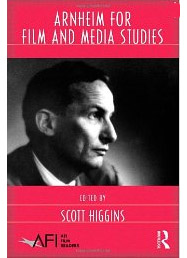 A new anthology seems likely to change that view. Arnheim for Film and Media Studies, edited by Scott Higgins, reveals one of the earliest and most energetic and pluralistic thinkers about modern media. The fourteen authors probe Arnheim’s ideas about film, of course–showing unexpected connections to the Frankfurt School and to avant-gardists like Maya Deren. But there are as well essays on Arnheim’s thinking on photography, television, and radio, along with studies that examine how his ideas would apply to comic books and digital media. Other contributors provide conceptual reconstructions, analyzing his ideas on composition and stylistic history.
A new anthology seems likely to change that view. Arnheim for Film and Media Studies, edited by Scott Higgins, reveals one of the earliest and most energetic and pluralistic thinkers about modern media. The fourteen authors probe Arnheim’s ideas about film, of course–showing unexpected connections to the Frankfurt School and to avant-gardists like Maya Deren. But there are as well essays on Arnheim’s thinking on photography, television, and radio, along with studies that examine how his ideas would apply to comic books and digital media. Other contributors provide conceptual reconstructions, analyzing his ideas on composition and stylistic history.
This is no esoteric exercise. The essays present probing arguments with patient lucidity. Encouragingly, most of the contributors are early in their careers. (I have a piece in the collection as well, an expanded version of a blog entry.) The anthology proves that a seminal thinker can always be reappraised. There’s always more to be understood.
In the Higgins collection Malcolm Turvey furnishes an essay on Arnheim’s relation to various strands of modernism. That vast movement is treated at greater length in Turvey’s new book, The Filming of Modern Life: European Avant-Garde Film of the 1920s. At the book’s core are close analyses of five exemplary films encapsulating various trends. Turvey studies Richter’s Rhythm 21 and abstract film, Léger and Murphy’s Ballet mécanique and cinéma pur, Clair’s Paris Qui Dort and Dada, Dalí and Buñuel’s Chien Andalou and Surrealism, and Vertov’s Man with a Movie Camera and the “city symphony” format. For each film Turvey provides informative historical background and, often, some controversial arguments. For example, he finds Léger to be surprisingly concerned with preserving classical standards of beauty. Indeed, one overall thrust of the book is to suggest that modernism was less a rejection of all that went before than a selective assimilation of valuable bits of tradition. (This applies as well to Eisenstein, I think, as I try to show in my book on his work.)
No less controversial is Turvey’s careful dissection of what has come to be known as “the modernity thesis.” This is the idea that urbanization, technological change, and other forces have fundamentally changed the way we perceive the world, perhaps even altered our basic sensory processes. Specifically, some argue, because the modern environment triggers a fragmentary, distracted experience, that experience is mimicked by certain types of film, or indeed by all films. Step by step Turvey argues that this is an implausible conclusion. This last chapter is sure to stir debate among the many scholars who argue for film’s essential tie to a modern mode of perception.
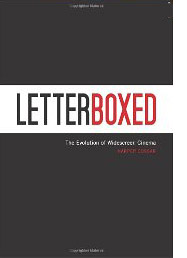 Harper Cosssar’s Letterboxed: The Evolution of Widescreen Cinema begins in the heyday of Arnheim and the silent avant-garde. Indeed, some of the early uses of widescreen, as in Gance’s Napoleon, are indebted to experimental film. But Cossar’s genealogy of widescreen also mentions horizontal masking in Griffith films like Broken Blossoms and lateral or stacked sets in Keaton comedies like The High Sign. More fundamentally, Cossar develops Charles Barr’s suggestion that the sort of viewing skills demanded by widescreen (at least in its most ambitious forms) were anticipated by directors who coaxed viewers to scan the 4:3 frame for a variety of information. The “widescreen aesthetic” was implicit in the old format, and technology eventually caught up to allow it full expression.
Harper Cosssar’s Letterboxed: The Evolution of Widescreen Cinema begins in the heyday of Arnheim and the silent avant-garde. Indeed, some of the early uses of widescreen, as in Gance’s Napoleon, are indebted to experimental film. But Cossar’s genealogy of widescreen also mentions horizontal masking in Griffith films like Broken Blossoms and lateral or stacked sets in Keaton comedies like The High Sign. More fundamentally, Cossar develops Charles Barr’s suggestion that the sort of viewing skills demanded by widescreen (at least in its most ambitious forms) were anticipated by directors who coaxed viewers to scan the 4:3 frame for a variety of information. The “widescreen aesthetic” was implicit in the old format, and technology eventually caught up to allow it full expression.
Cossar advances to more familiar ground, studying early widescreen practice in The Big Trail and moving to analyses of films by masters like Preminger, Ray, Sirk, and Tashlin. Although most chroniclers of the tradition stop in the early 1960s, Cossar presses on to consider the changes wrought by split-screen films like The Boston Strangler and The Thomas Crown Affair. The survey concludes with discussions of cropping techniques in digital animation (e.g., Pixar) and web videos, which often employ letterboxing as a compositional device. In all, Letterbox traces recurring technological problems and aesthetic solutions across a wide swath of film history.
Critics’ corner
Two of America’s senior film writers have revisited their earlier writings, with lively results. Dave Kehr’s collection When Movies Mattered samples his Chicago Reader period, from 1974 to 1986. Disguised as weekly reviews, Kehr’s pieces were nuanced essays on films both contemporary and classic.
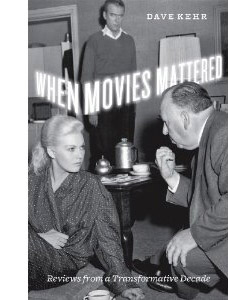 Turn to any of them and you will find a relaxed intelligence and a deep familiarity with film history. By chance I open to his essay on Billy Wilder’s Fedora:
Turn to any of them and you will find a relaxed intelligence and a deep familiarity with film history. By chance I open to his essay on Billy Wilder’s Fedora:
It resurrects the flashback structure of his 1950 Sunset Boulevard, but it goes further, placing flashbacks with flashbacks and complicating the time scheme in a manner reminiscent of such demented 40s films noirs as Michael Curtiz’s Passage to Marseille and John Brahm’s The Locket. . . But the jumble of tenses also clarifies the film’s design as a subjective stream of consciousness. The images come floating up, appearing in the order of memory.
How many of those reviewers whose flash-fried opinions count for so much on Rotten Tomatoes can summon up information about the construction of Passage to Marseille or The Locket? And how many could make the case that Wilder, in returning to the forms fashionable in his early career, would repurpose them for the sake of a reflection on death, resulting in “a film as deeply flawed as it is deeply felt”? Kehr’s work from this period is appreciative criticism at its best, and he never lets his knowledge block his immediate response. “I admire Fedora, but it also frightens me.” It’s time we admitted that Dave Kehr, working far from both LA and Manhattan, was writing some of the most intellectually substantial film criticism we have ever had.
Also hailing from the Midwest is Joseph McBride, a professor, critic, and biographer. Apart from his rumination on Welles, his books have focused on popular, even populist, directors like Capra (The Catastrophe of Success), Ford (Searching for John Ford), and Spielberg (Steven Spielberg: A Biography). The University Press of Mississippi and bringing first two volumes of this trilogy back into print, and it has just reissued the third in an updated edition.
Here Spielberg emerges as far more than a purveyor of popcorn movies. McBride sees him as a restless, wide-ranging artist, and the additions to the original book have enhanced his case. McBride offers persuasive accounts of Amistad and A.I., which he regards as major achievements. He goes on to argue that Spielberg’s unique power in the industry allowed him to face up to central political issues of the 2000s.
He made a series of films in various genres reflecting and examining the traumatic effects of the September 11, 2001, attacks and the repression of civil liberties in the United States during the George W. Bush/ Dick Cheney regime. . . . No other major American artist confronted the key events of the first decade of the century with such sustained and ambitious treatment (450).
McBride is no cheerleader. He can be as severe on Spielberg’s conduct as on his films, criticizing much of the DreamWorks product as dross and suggesting that Spielberg sometimes trims his sails in interviews. I’d contend that McBride underrates some of Spielberg’s work, notably Catch Me If You Can and The War of the Worlds. But McBride has perfected his own brand of critical biography, blending personal information (he reads the films as autobiographical), tendencies within the film industry and the broader culture, and critical assessment. All studies of Spielberg’s work must start with McBride’s monumental book. Ten years from now we can look forward to another update; surely his subject will have made a few more movies by then.
Foreign accents
8 1/2.
Today we regard Citizen Kane as a classic, if not the classic. But for several years after its 1941 release it wasn’t considered that great. It missed a place on the Sight and Sound ten-best critics’ polls for 1952; not until 1962 did it earn a spot (though at the top). Its rise in esteem was due to changes in film culture and, some have speculated, the fact that Kane was a regular on TV during the 1960s. Something similar happened with His Girl Friday, another stealth classic. I’ve traced what I know about its entry into the canon in an earlier blog entry.
What about the postwar classics like Open City and Bicycle Thieves and the works of Bergman and Fellini and Antonioni and Kurosawa and the New Wave? Surely some of the films’ fame comes from their intrinsic quality—many are remarkable movies—but would we regard them the same way if their reputation hadn’t spread so widely abroad, especially in America? Questions like this lead us to what film scholars have come to call canon formation: the ways artworks come to wide notice, receive critical acclaim, and eventually become taken for granted as classics.
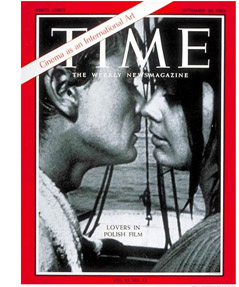 Consider this. The Toronto International Film Festival’s recent list of 100 essential films includes thirty non-Hollywood titles from the 1946-1973 period, more than from any comparable span. Of the TIFF top twenty-five, twelve are from that era. You can argue that these years, during which several generations of viewers overlapped, set in place a system of taste that persists to this day.
Consider this. The Toronto International Film Festival’s recent list of 100 essential films includes thirty non-Hollywood titles from the 1946-1973 period, more than from any comparable span. Of the TIFF top twenty-five, twelve are from that era. You can argue that these years, during which several generations of viewers overlapped, set in place a system of taste that persists to this day.
Tino Balio’s Foreign Film Renaissance on American Screens, 1946-1973 reveals a side of canon formation that’s too often overlooked. Balio is less concerned with analyzing films than Turvey, Cossar, Kehr, and McBride are. He is asking a business question: What led the U. S. film industry to accept and eventually embrace films so fundamentally different from the Hollywood product?
Several researchers have pointed to the roles played by influential critics, film festivals, and new periodicals like Film Comment and Film Culture. Intellectual and middlebrow magazines promoted the cosmopolitan appeal of the foreign imports. By 1963 Time could run a feverish cover story on “The Religion of Film” to coincide with the first New York Film Festival.
Balio duly notes the importance of such gatekeepers and agenda setters. But he goes back to the beginnings, with the small import market of the 1930s. Turning to the prime postwar phase, he broadens the cast of players to include the business people who risked buying, distributing, and publicizing movies that might seem hopelessly out of step with US audiences. He shows how small importers brought in Italian films at the end of the 1940s, and these attracted New York tastemakers, notably Times critic Bosley Crowther, who were keen on social realism. Within a few years ambitious entrepreneurs were marketing British comedies, Swedish psychodramas, Brigitte Bardot vehicles, and eventually the New Waves and Young Cinemas of the 1960s. As distributors fought censors and slipped films into East Side Manhattan venues, an audience came forward. The “foreign films”—often recut, sometimes dubbed, usually promoted for shock, sentiment, and sex—were positioned for the emerging tastes of young people in cities and college towns.
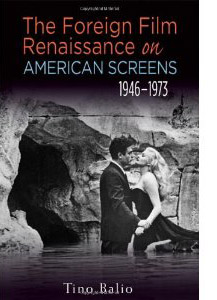 Balio offers fascinating case studies of how the films were handled well or badly. Kurosawa, he notes, had no consistent distributor in the US, and so his films gained comparatively little traction. By contrast there was what one chapter calls “Ingmar Bergman: The Brand.”
Balio offers fascinating case studies of how the films were handled well or badly. Kurosawa, he notes, had no consistent distributor in the US, and so his films gained comparatively little traction. By contrast there was what one chapter calls “Ingmar Bergman: The Brand.”
Bryant Haliday and Cy Harvey of Janus Films. . . devised a successful campaign to craft an image of Bergman as auteur and to carefully control the timing of each release. . . . Janus released the films in an orderly fashion to prevent a glut on the market and to milk every last dollar out of the box office. No other auteur received such treatment.
The work paid off: Bergman made the cover of Time in 1960, and soon The Virgin Spring and Through a Glass Darkly won back-to-back Oscars for Best Foreign Language Film. Eventually, Bergman and other foreign auteurs attracted the big studios. Now that small distributors had shown that there was money in coterie movies, the major companies (having problems of their own) embraced imported cinema—first through distribution and eventually through financing. If you admire Godard’s The Married Woman, Band of Outsiders, and Masculine Feminine you owe a debt to Columbia Pictures, which underwrote them.
Work like Balio’s does more than bring the name Cy Harvey into film history. It reminds us to follow the money. If we do, we’ll see that not every “foreign film” stands radically apart from big bad Hollywood. More generally, The Foreign Film Renaissance on American Screens reminds us that even high-art cinema is produced, packaged, and circulated in an economic system. The distinction between commercial films and personal films, business versus art, is a wobbly one. Rembrandt painted on commission and Mozart was hired to write The Magic Flute. Sometimes good art is good business.
I couldn’t work this in anywhere else: The bulk of the essays in Arnheim for Film and Media Studies are by people associated with our department at Wisconsin. They do us proud, naturally. Incidentally, Joe McBride went to school at UW too, and Tino and I taught together here for over thirty years.
Dave Kehr maintains a blog and teeming forum here.
Hart Perez has made a documentary, Behind the Curtain: Joseph McBride on Writing Film History. An excerpt is here. McBride’s website has information about his many projects.
James E. Cutting provides an unusually precise account of canon creation in his 2006 book Impressionism and Its Canon, available for free download here. I’ve written an earlier blog entry discussing Jim’s research into film.
My mention of American generations is based on Elwood Carlson’s study The Lucky Few: Between the Greatest Generation and the Baby Boom. Carlson examines the varying experiences and life chances of people who fought in World War II; people who came of age during the 1960s; and the less populated cohort that fell in between. Doing some pop sociology, I’d hypothesize that the art-film market’s growth relied on a convergence of all three, which were more disposed to art film than cohorts in earlier periods. For example, veterans who had served overseas and gone to college on the GI Bill were more familiar with non-US cultures than their parents and, I surmise, weren’t entirely put off by foreign films. When I first met Kristin’s mother, Jean Thompson, she already knew the work of Carl Dreyer, having seen Day of Wrath at an art cinema in Iowa City. She was in graduate school after World War II, on the G.I. Bill, as was her new husband, Roger, also in school on the G.I. Bill and managing that art cinema. They saw Children of Paradise and other wartime foreign films just getting their releases in the U.S., as well as post-war films like Bicycle Thieves.
The Lucky Few, also known as the Good Times generation, were born between the late twenties and the early 1940s. They were well placed to enjoy postwar prosperity and the period’s explosion of artistic expression. The Lucky Few cohort includes powerful film critics like John Simon (born 1925), Andrew Sarris (1928), Richard Roud (1929), Eugene Archer (1931), Susan Sontag and Richard Schickel (1933), and Molly Haskell (1939). Aged between twenty and thirty when the foreign-film wave struck, they were mighty susceptible to it. (Pauline Kael, though born in 1919, had a delayed career start, entering film journalism in the 1950s along with Sarris et al.) You might slip in David Thomson (born 1941), Jonathan Rosenbaum (1943), and Richard Corliss (1944).
The Baby Boomers jumped on the carousel in the 1960s, with results that are all too apparent. Dave Kehr and Joe McBride are Boomers, as are Kristin and I. Tino, for the record, is ageless.
Minority Report.
Ratio-cination
Beyond a Reasonable Doubt.
DB here:
Good timing. Just as I was about to enable more aspect-ratio fetishism, I got news of the publication of Widescreen Worldwide, from John Libbey. Edited by John Belton, Sheldon Hall, and Steve Neale, it has its distant origins in a 2003 conference at the National Media Museum in Bradford, England. Widescreen Worldwide will be a very useful volume, with material on little-studied U. S. systems and a lot of information on formats in Japan, France, Italy, and Russia, even Norway. 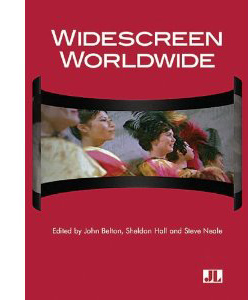 Most studies of widescreen technology seldom discuss the creative uses to which it was put. But this collection features several essays focusing on the artistry of the wide formats, emphasizing the work of Preminger, Peckinpah, Okamoto, Suzuki, et al. As the publisher’s blurb puts it:
Most studies of widescreen technology seldom discuss the creative uses to which it was put. But this collection features several essays focusing on the artistry of the wide formats, emphasizing the work of Preminger, Peckinpah, Okamoto, Suzuki, et al. As the publisher’s blurb puts it:
The book documents how the aesthetic strategies explored during the first wave of American widescreen films underwent revision in Europe and Asia as filmmakers brought their own idiolect to the language of widescreen mise-en-scène, editing, and sound practices. As a global phenomenon, widescreen cinema thus presents the opportunity to examine how different cultures appropriate the technology to advance extremely different cultural and aesthetic agendas.
I have an essay included on the Shaw Brothers directors, and I’m happy to be in such distinguished company in this major publication. My essay is available on this site. The paper I gave at the conference, on Hou Hsiao-hsien’s early anamorphic films, is also posted here.
Speaking of widescreen: Today, we go back to While the City Sleeps and SuperScope, thanks to some correspondents and further fooling around on my part.
Ratio decidendi
The story so far: SuperScope was a widescreen system devised by Irving and Joseph Tushinsky for RKO . It extracted a wide image from the 1.37 standard frame and printed it as a squeezed anamorphic frame, to be unsqueezed at a ratio of 2.0 to 1. (A later version allowed for a 2.35 stretch.) In principle, it’s an early version of what Super 35 does now. Some RKO films, notably Invasion of the Body Snatchers (1956), were shot in knowledge that they would be given the SuperScope treatment; others were SuperScoped after the fact.
The question before the jury was: Do SuperScope prints of Lang’s While the City Sleep (1956) faithfully reflect his intentions? The answer I settled on was: Probably not. A Variety story indicated that the SuperScope prints were made for European distribution, though perhaps some sneaked into the US theatrical market or the 16mm aftermarket.
Now for a little more on Lang’s compositions. Several viewers have commented on all the headroom visible in the full frame. The ‘Scope print I examined displayed some as well, but not as much, as my illustrations for the earlier entry indicate. More likely the film was masked in the US to something like 1.66 or 1.75. I reproduced some frames from a 1.75 laserdisc version, and they look reasonably good. Overall, I suggested that City’s fairly open compositions suggest that Lang was expecting the film to be masked somewhat in projection, but not to the full 2.0:1 ratio we get with SuperScope.
Although for most of its length, While the City Sleeps seems quite okay at 2.0, I found one shot that would be quite awkward in full SuperScope. Alas, I didn’t photograph it from the 35mm European print I examined, but I’ve used my stills from the print to guide my cropping of the 1.37 frame in this instance. The results are, as the lawyers say, probative.
The scene is mundane: Walter Kyle gets a phone call from his errant wife Dorothy. She’s carrying on an affair with Harry, the art director of the newspaper Walter runs. Walter talks with her, and Lang cuts to her responding. I show you the 1.75 versions.
When Lang cuts back to Walter, he provides a new camera setup featuring the butler Steven. This is to prepare us for a joke: Walter says he’ll have Steven meet Dorothy at the front door in his underwear. Steven reacts with embarrassment. Given that a lot of the film plays on the sexual rapacity of men, the humor is a shade sick.
A narrative convention: The stuffy, puritanical butler. But notice that in the 1.75 frame, Steven’s full face is quite visible. Of course it’s even more visible in the full-frame version. (Fussy Lang, or fussy somebody, seems to have aligned the face with the swoop of the ceiling.)
But the composition would look more awkward if chopped in the SuperScope 2.0:1 version. Here’s one framing, using the cropping points typical of other anamorphic shots in the European 35mm print.
In addition, since the crop slices more off the bottom region than the top, Walter’s body is also lost in the anamorphic version. But this is still probably the best compromise. Some frames in the 35mm S’Scope version favor the lower region of the original shot. But in this shot that option would be disastrous.
It’s hard to imagine that the director of the painstakingly composed Moonfleet (1955) would have wanted to saw Steven’s skull in half.
Mors ultima ratio
So Lang didn’t shoot the film expecting it to be SuperScoped. Nevertheless, things that escape directors’ intentions can have their own impact on viewers. In the codicil to the earlier blog entry, I wondered if French critics’ admiration for While the City Sleeps might have been based on their seeing wider prints than Americans did—in effect, gathering Lang into the cohort of skilled anamorphic filmmakers that included Ray, Preminger, Minnelli, et al. Samuel Bréan wrote to tell me that one critic, Jacques Lourcelles, raised this issue explicitly. Lourcelles writes:
For both this film and Lang’s next film, Beyond a Reasonable Doubt, the format poses a thorny problem that can be resolved only by considering aesthetic matters. The film, not shot in CinemaScope, was exhibited in Superscope (a wide format used at RKO and created through laboratory processes), and then in a normal format. Which is better? In my opinion, the wider one. Only there, for instance, do the camera movements and the newspaper-office set have their true impact. Even if the Superscope version was “manufactured” in the lab, Lang knew that the film would be seen on the wide screen and his direction was conceived as a function of that. The same goes for Beyond a Reasonable Doubt; to cite just one instance, the first sequence showing the condemned man walking toward the electric chair is obviously conceived for the wider format.
This does lead to some intriguing speculation on how “misreadings” of films can have positive consequences. The French celebration of Lang’s 1950s films led American and British critics to reevaluate them.
The case of Beyond a Reasonable Doubt is quite parallel to that of While the City Sleeps. Released in September 1956, it too was reviewed in Variety as a non-anamorphic picture. Its U. S. publicity makes no reference to a widescreen format. But its overseas posters claim that it is in “RKO-Scope.” Huh?
By the end of 1956, the Tushinskys had split from RKO and were selling SuperScope generally. So in November 1956 RKO simply announced that it had developed “a new widescreen, anamorphic process” that would carry a ratio of 2.0:1. Historians of widescreen have assumed that this is SuperScope by another name. The same publicity announced that soon all the studio’s films would be in RKO-Scope. But RKO ceased making movies on 1 January 1957. Universal took over distributing the remaining pictures.
Again, on the basis of the posters and Lourcelles’ comments we can be confident that Beyond a Reasonable Doubt was shown in a 2.0:1 aspect ratio in some overseas markets. As airless a movie as Lang ever made, with disconcertingly generic sets and severe framings and camera movements, it engendered a fascination in French critics. The story itself is a model of Langian guilty conscience. A reporter looking for a new book to write agrees to a hoax that will attack capital punishment. He’ll plant clues indicating that he’s a murderer in order to prove that an innocent man can be convicted. Lang’s narration offers his customary feints and ellipses. Smooth hooks, verbal and visual, carry us across scenes. Casual details are dropped in, or a sudden cutaway appears, and we’re misled into thinking we’re ahead of the plot. We are in fact behind it. Crucial story information is skipped over, but we’re not aware of what has been deleted until much later. We should have noticed.
Appearing in the same year as Around the World in 80 Days, The King and I, Lust for Life, Giant, Anastasia, War and Peace, and other sweeping spectacles, Beyond a Reasonable Doubt was a bare-bones programmer. Lang’s last American film doesn’t waste its energy on the pictorial flourishes of budget-strapped directors like Siegel or Fuller. Other B-films could whip up visual flair with chiaroscuro, close-ups, and fast cutting, but Lang’s images seem disconcertingly banal; yet their simplicity gives them an odd purity. In an influential review, Jacques Rivette declared that Lang was, in effect, filming concepts.
I don’t find any shots in Beyond with a vertical bias comparable to the shot featuring Steven the butler in City. The 1.37 frame shots are very empty up top. So here’s an experiment in reconstructing an approximation of what Europeans saw.
Dux vitae ratio
As I suggested in the earlier blog, for decades Lang composed his frames carefully, balancing figures in dynamic patterns and sometimes putting important elements along the sides or in a corner. Here are some examples from one of his most beautiful films, The Ministry of Fear. He likes triangular compositions that tuck heads into corners, as well as camera angles that let foreground items anchor the faces and bodies.
When the frame is unbalanced, it’s for a reason, such as purse-rifling.
A director so committed (like Ozu) to putting heads high in the shot must have felt annoyed when he had to hang inexpressive space over his players, as in the shot at the very top of today’s entry. When he left headroom in earlier films, it served an exacting compositional purpose, as you see below. Those wedge-formations of tapers, backing up threatening cobras, look back to the decor of his German films.
I suspect that it pained him to accept the more open framing demanded by non-anamorphic ratios. In CinemaScope you could count, more or less, on the proportions of your image being respected. But shooting flat, could you really be sure what would stay in the shot? Projectionists could mask it to 1.66, 1.75, 1.85, and even wider. These ratios were so imprecise, and this is one precise director. Lang “shot to protect,” as they say, but he couldn’t protect what was already gone: his compact, quietly masterful compositions.
John Belton wrote to me to echo the idea that Lang would probably have realized that While the City Sleeps would be cropped to as much as 1.75.
Certainly every director after 1954 composed for wide screen projection. As for SuperScope, why didn’t they just project it flat with a 2:1 matte in the aperture? It certainly would have looked sharper. Maybe the answer lies in the relative abundance of CinemaScope installations overseas?
Good question for further research. Another interesting sidelight: Who was the SuperScope representative for Europe? For a time, apparently none other than Edgar G. Ulmer! Ulmer is identified as a SuperScope representative in “Tushinsky’s Teuton Deal,” Variety, 7 September 1956, p. 5. Michael Campi wrote to inform me that in Australia he too saw a 2.0:1 print of While the City Sleeps.
RKO’s announcement of RKO-Scope can be found in “And Now–RKO-Scope,” Variety, 30 November 1956, p. 1. More background on the winding down of the studio is provided in Richard B. Jewell and Vernon Harbin, The RKO Story (London: Octopus, 1982), pp. 242-245.
The Jacques Lourcelles comment appears in his Dictionnaire du cinéma vol. 3 (Paris: Laffont, 1992), p. 294. I’m grateful to Samuel Bréan for calling my attention to it. Rivette’s 1957 essay on Beyond a Reasonable Doubt, “The Hand,” is available in Cahiers du cinéma: The 1950s: Neo-Realism, Hollywood, New Wave, ed. Jim Hillier (Cambridge: Harvard University Press, 1985), pp. 140-144. It has been included in a site devoted to Jacques Rivette, Order of the Exile. (The hand Rivette refers to is that in the shot of the warrant above; had Rivette not seen the RKO-Scope print, he might have had to title the essay, “The Hands.”) The poster images for Beyond a Reasonable Doubt come from the ever-generous DVD Beaver, and its review of a Spanish disc.
The Ministry of Fear.












